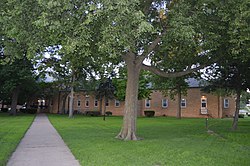Mason County, Illinois | |
|---|---|
 Mason County Courthouse, Havana | |
 Location within the U.S. state of Illinois | |
 Illinois's location within the U.S. | |
| Coordinates: 40°14′N89°55′W / 40.24°N 89.91°W | |
| Country | |
| State | |
| Founded | 1841 |
| Named after | George Mason |
| Seat | Havana |
| Largest city | Havana |
| Area | |
• Total | 563 sq mi (1,460 km2) |
| • Land | 539 sq mi (1,400 km2) |
| • Water | 24 sq mi (62 km2) 4.3% |
| Population (2020) | |
• Total | 13,086 |
• Estimate (2024) | 12,543 |
| • Density | 24.3/sq mi (9.37/km2) |
| Time zone | UTC−6 (Central) |
| • Summer (DST) | UTC−5 (CDT) |
| Congressional district | 15th |
| Website | www |
Mason County is a county in the U.S. state of Illinois. According to the 2020 census, it had a population of 13,086. [2] Its county seat is Havana. [3] The county is named in honor of George Mason, a member of the Virginia legislature who campaigned for the adoption of the United States Bill of Rights.
Contents
- History
- Geography
- National protected area
- State Forest
- State Fish & Wildlife Areas
- Climate and weather
- Adjacent counties
- Transportation
- Public Transportation
- Major highways
- Demographics
- 2020 census
- 2010 census
- Communities
- Cities
- Villages
- Census-designated place
- Other unincorporated communities
- Townships
- Politics
- Education
- See also
- References

